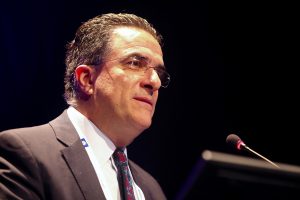
Sadeer Hannush MD
Carrying out high-quality clinical research is “a moral imperative” and its importance in advancing medicine, and thus improving outcomes for patients, cannot be overstated, delegates attending the 10th EuCornea Congress Medal Lecture in Paris, France, were told.
The esteemed lecture was presented by a long-time supporter of EuCornea, Sadeer Hannush MD, USA, on the topic of “Clinical Corneal Research: Why It Is Important to Get Involved”.
The lecture drew on Dr Hannush’s three-decade post-training experience in the areas of cornea and external disease, maintaining a private practice while being actively involved in significant academic research.
Answering why one should become involved in research, Dr Hannush commented: “An average ophthalmologist may touch the lives of 40,000 people during the course of a career. If we change practice patterns, on the other hand, we can touch the lives of millions.”
Dr Hannush acknowledged that doing research doesn’t come easy; “you have to learn the trade of it”, and outlined a number of practical tips for becoming involved in high-quality studies. The first steps involve “not being content with the ‘what and how’, and having a drive to answer why”.
Good-quality research “should ask a simple, high-impact question” and should aim to be practice-confirming or practice-changing, he said.
Dr Hannush’s personal journey through clinical corneal research has seen him involved with such important studies as ‘Prospective Evaluation of Radial Keratotomy’, ‘The Collaborative Corneal Transplantation Studies’, ‘Herpetic Eye Disease Studies’, ‘Cornea Donor Study (CDS)’, ‘Corneal Preservation Time Study (CPTS)’ and ‘Long-term Survival of Permanent Keratoprosthesis’. Each of these studies asked a simple, high-impact question that could be answered with a well-defined answer, he noted.
The common factor in all of them was collaboration, something that is essential for robust and sound clinical research, and key to having the right expertise for each part of the research project, he stressed. “You have to work with others – very few of us can do it on our own... we can all collaborate to do this. We don’t all have to do every element of the research.
“Some of us are better at certain things than others. Maybe you are an expert at reading images – you can make your contribution there. Or maybe you are a good writer and can participate in that manner. There is a lot more to collecting and reporting data than simply making the observation or doing the surgery. So, if you are receptive to the idea of collaboration with others, even at a very young age, especially at a very young age, then I would encourage you to keep your eyes and ears open and be receptive to, indeed welcoming of, the approaches of colleagues, especially seniors
in the field, when you are tapped to participate in a study.”
Speaking about the findings of his own high-impact work over the years, Dr Hannush noted how research can confirm something that clinicians suspect from practice, or it can throw up surprises.
For example, Dr Hannush quoted research he collaborated on that showed that corneal transplant patients with higher levels of education have more successful grafts for keratoconus than patients with less education. “You may think you didn’t need a study to figure that out; it’s obvious. These are patients that are going to follow instructions, learn about complications, turn up for their post-op visits and take their topical medications. All of that is true, but unless you evaluate it with a rigorous scientific method and the help of a statistician, you don’t know this to be true. Sometimes you are surprised, as we were with the CDS and CPTS studies.”
He explained how the CDS and CPTS studies showed that older cornea donor age (even at 70 years old) does not result in poorer quality outcomes, and neither does longer preservation time (eight-to-11 days), “This has increased the number of donor tissue available for transplantation significantly”.
Prior to these studies it was believed that cornea donors should ideally be under the age of 65, and corneal tissue preserved in cold storage should ideally be transplanted if the duration of preservation was under a week. This knowledge is practice-changing. “How many ophthalmologists are surprised by these findings? I was! We learned a lot from collaboration in these studies,” Dr Hannush said.
Dr Hannush acknowledged that change is hard, but that clinicians must be open to believing and accepting key new study findings and incorporating them into their clinical practices, when the results prove a certain approach has the best outcomes. “This is very important in clinical trials – to believe the results of a well constructed and executed trial/study that you and your colleagues contribute to.”
Concluding his EuCornea Medal Lecture, Dr Hannush said: “Treating patients changes the lives of the few you treat. Changing practice patterns amongst colleagues affects the lives of many. Collaborative clinical research is the only way to make this possible. It is our responsibility and a moral imperative!”

 Sadeer Hannush MD
Sadeer Hannush MD